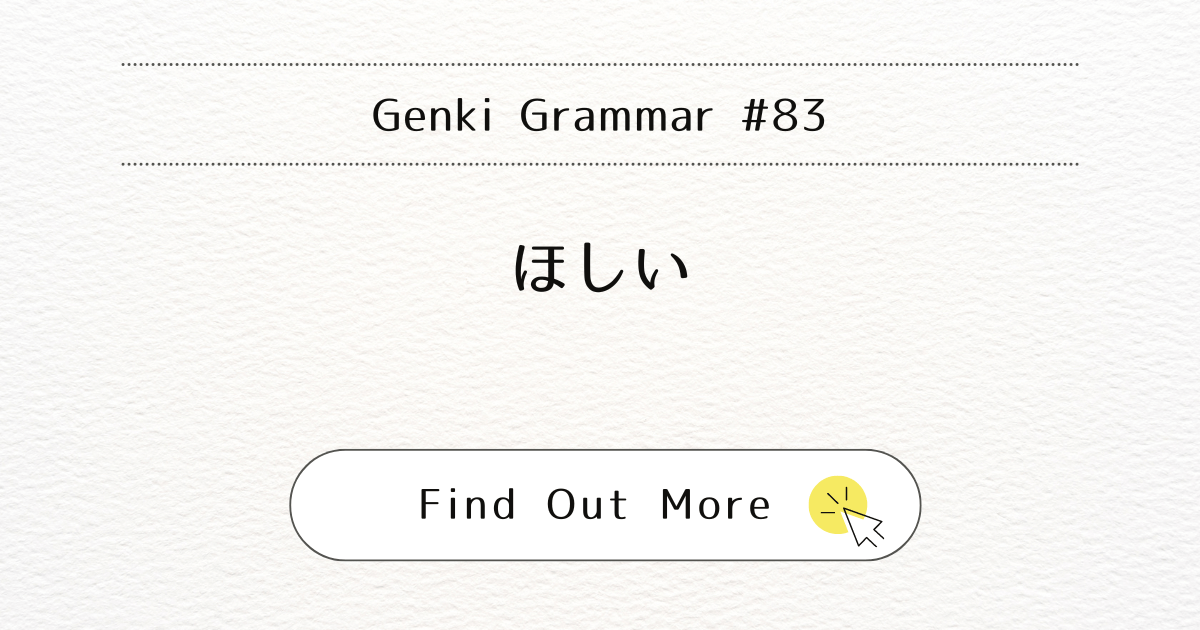
Introduction
In Japanese, ほしい (hoshii) is a useful word to express the desire for something. This blog post will guide you on how to use ほしい correctly and simply in your sentences.
What It Means
ほしい (hoshii) means “to want (something).” It follows the same pattern as い-adjectives. When using ほしい, the thing you want is usually marked by the particle が (ga). In negative sentences, you may also use the particle は (wa).
When You Use It
Use ほしい when you want to express that you desire something. It’s similar to たい (tai), which means “to want to do something,” but ほしい is specifically used for expressing a desire for things, not actions.
Examples
Here are some examples to help you understand how to use ほしい:
- いい成績がほしいです。(Ii seiseki ga hoshii desu.)
I want a good grade. - 子供の時、スケートボードが欲しかったです。(Kodomo no toki, sukeetoboodo ga hoshikatta desu.)
When I was young, I wanted a skateboard. - A: プレゼントがほしい?(Purezento ga hoshii?)
Do you want a present?
B: ううん、ほしくない。(Uun, hoshikunai.)
No, I don’t.
You can use the structure (私は) Xがほしい (Watashi wa X ga hoshii) to say “I want X.”
Talking About Others’ Desires
ほしい is usually used to talk about your own desires. To talk about what someone else wants, you can:
- Quote what they said:
マリアさんは新しいスマホがほしいと言っています。(Maria-san wa atarashii sumaho ga hoshii to itteimasu.)
Maria says she wants a new phone. - Make a guess:
マイクさんはぬいぐるみはほしくないでしょう。(Maiku-san wa nuigurumi wa hoshikunai deshou.)
Mike probably doesn’t want a stuffed animal.
Or, you can use the verb ほしがる (hoshigaru) to describe someone else’s desire. Unlike ほしい, ほしがる uses the particle を (o) after the object of desire.
- りくさんは英語を習いたがっています。(Riku-san wa eigo o naraitagatteimasu.)
Riku wants to study English. - マイクさんは友だちをほしがっています。(Maiku-san wa tomodachi o hoshigatteimasu.)
Mike wants a friend.
Note
Since ほしい expresses a desire to possess something, if you can use a verb + たい instead, it’s usually better to use the verb. For example:
- 昼ご飯が食べたい。(Hirugohan ga tabetai.)
I want to eat lunch. (not 昼ご飯がほしい) - 旅行に行きたい。(Ryokou ni ikitai.)
I want to go on a trip. (not 旅行がほしい)
Also, certain words like かなしい (kanashii, sad), うれしい (ureshii, glad), and いたい (itai, painful) are usually limited to first-person descriptions. Here are examples of how to use these words:
- かなしい (kanashii, sad):
(私は)かなしいです。((Watashi wa) kanashii desu.)
I am sad.
(Talking about someone else’s sadness directly with かなしい would be uncommon. Instead, you might say something like マリアさんはかなしそうです。Maria-san wa kanashisou desu, meaning “Maria looks sad.”) - うれしい (ureshii, glad):
試験に合格して、(私は)うれしいです。(Shiken ni goukaku shite, (watashi wa) ureshii desu.)
I am glad that I passed the exam.
(To describe someone else’s happiness, you might say マイクさんはうれしそうです。Maiku-san wa ureshisou desu, meaning “Mike looks happy.”) - いたい (itai, painful):
(私は)頭がいたいです。((Watashi wa)Atama ga itai desu.)
I have a headache.
(You would usually avoid saying someone else is in pain directly. Instead, you might say マリアさんは頭がいたそうです。Maria-san wa atama ga itasou desu, meaning “Maria seems to have a headache.”)
Conclusion
Mastering ほしい (hoshii) will allow you to express your desires clearly in Japanese. Remember that it’s mainly used for your own wants, and you’ll need other methods to talk about others’ desires.



